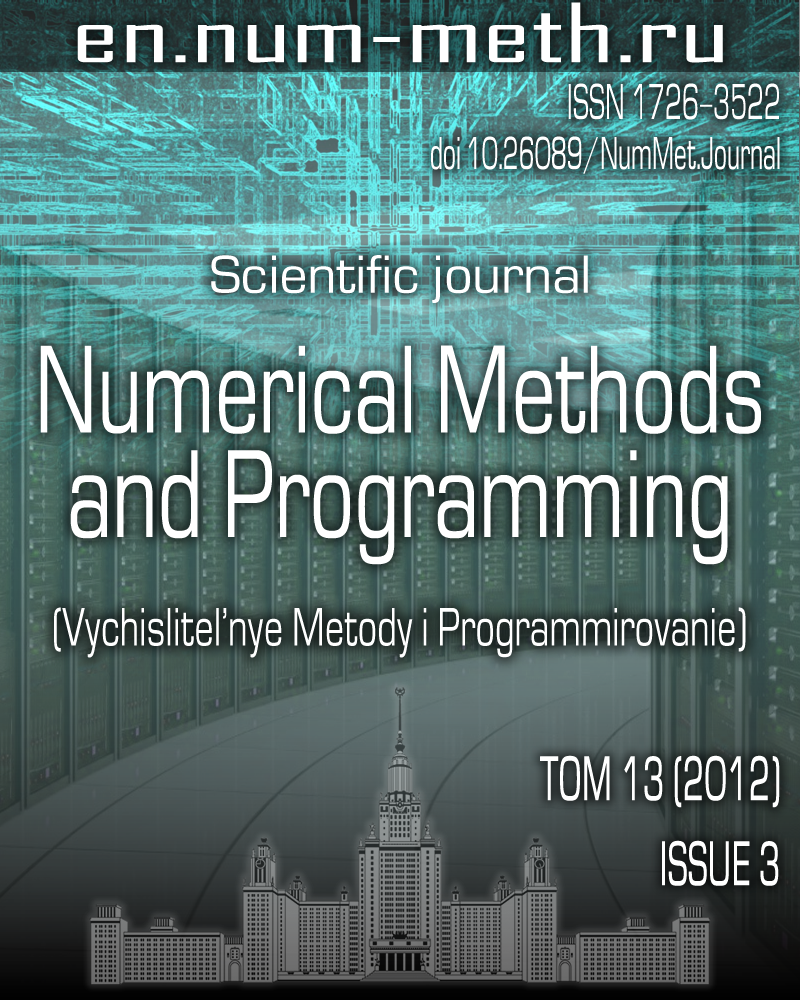The MEL program for the atomistic modeling of functional layers in solar cells
Keywords:
modeling of solar cells structure
global optimization of structure
modeling of periodic structures
Abstract
A new method for the atomistic modeling of periodic structures formed by organic and hybrid molecules is proposed. These structures are used to manufacture the organic and hybrids solar cells. In the framework of this method, the energy of interatomic interaction is calculated using the classical force field. The search of the most stable periodic configurations is performed using a genetic algorithm for the global optimization. A software implementation of the method is described. The efficiency of the proposed parallel version is analyzed. The test calculations of the periodic structure based on the fullerene molecule are discussed.
Published
2012-09-28
Issue
Section
Section 1. Numerical methods and applications
References
- de Falco C., Sacco R., Verri M. Analytical and numerical study of photocurrent transients in organic polymer solar cells // Computer Methods in Applied Mechanics and Engineering. 2010. 199. 1722-1732.
- Cheung D.L., Troisi A. Modelling charge transport in organic semiconductors: from quantum dynamics to soft matter // Phys. Chem. Chem. Phys. 2008. 10. 5941-5952.
- Northrup J.E. Atomic and electronic structure of polymer organic semiconductors: P3HT, PQT, and PBTTT // Phys. Rev. B. 2007. 76. 245202(1-6).
- Goldberg D.E. Genetic algorithms in search, optimization, and machine learning. Reading: Addison-Wesley, 1989.
- Goldberg D.E. Real-coded genetic algorithm, virtual alphabets, and blocking // Complex Systems. 1991. 5. 139-167.
- Goldberg D.E., Deb K. A comparative analysis of selection schemes used in genetic algorithms // Foundations of genetic algorithm. Rawlins G.J. E. (Ed.). San Mateo: Morgan Kaufmann. 1991. 69-93.
- Halgren T.A. Merck molecular force field // J. Comp. Chem. 1996. 17.
- Романов А.Н., Кондакова О.А., Григорьев Ф.В., Сулимов A.В., Лущекина С.В., Мартынов Я.Б., Сулимов В.Б. Компьютерный дизайн лекарственных средств: программа докинга SOL // Вычислительные методы и программирование. 2008. 9, № 2. 64-84.
- Антонов А.С. Параллельное программирование с использованием технологии MPI. М.: Изд-во Моск. ун-та, 2004.
- Антонов А.С. Параллельное программирование с использованием технологии OpenMP. М.: Изд-во Моск. ун-та, 2009.
- http://parallel.ru/cluster/lomonosov.html
- Singh T.B., Sariciftci N.S., Yang H., Yang L., Plochberger B., Sitter H. Correlation of crystalline and structural properties of C-60 thin films grown at various temperature with charge carrier mobility // Appl. Phys. Lett. 2007. 90. 213512.
- Керл Р.Ф., Смолли Р.Э. Фуллерены // В мире науки. 1991. 12. 14-24.
- Елецкий А.В., Смирнов Б.М. Фуллерены и структура углерода // Успехи физич. наук. 1995. 165, № 9. 977-1009.


